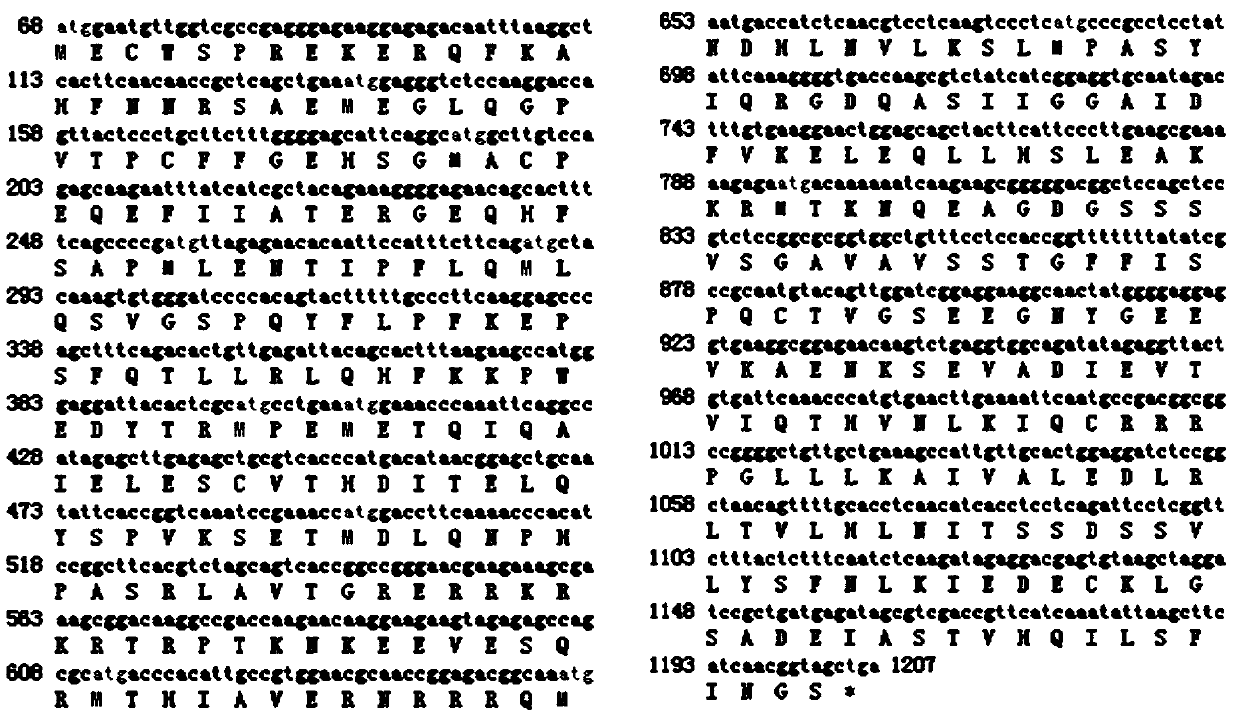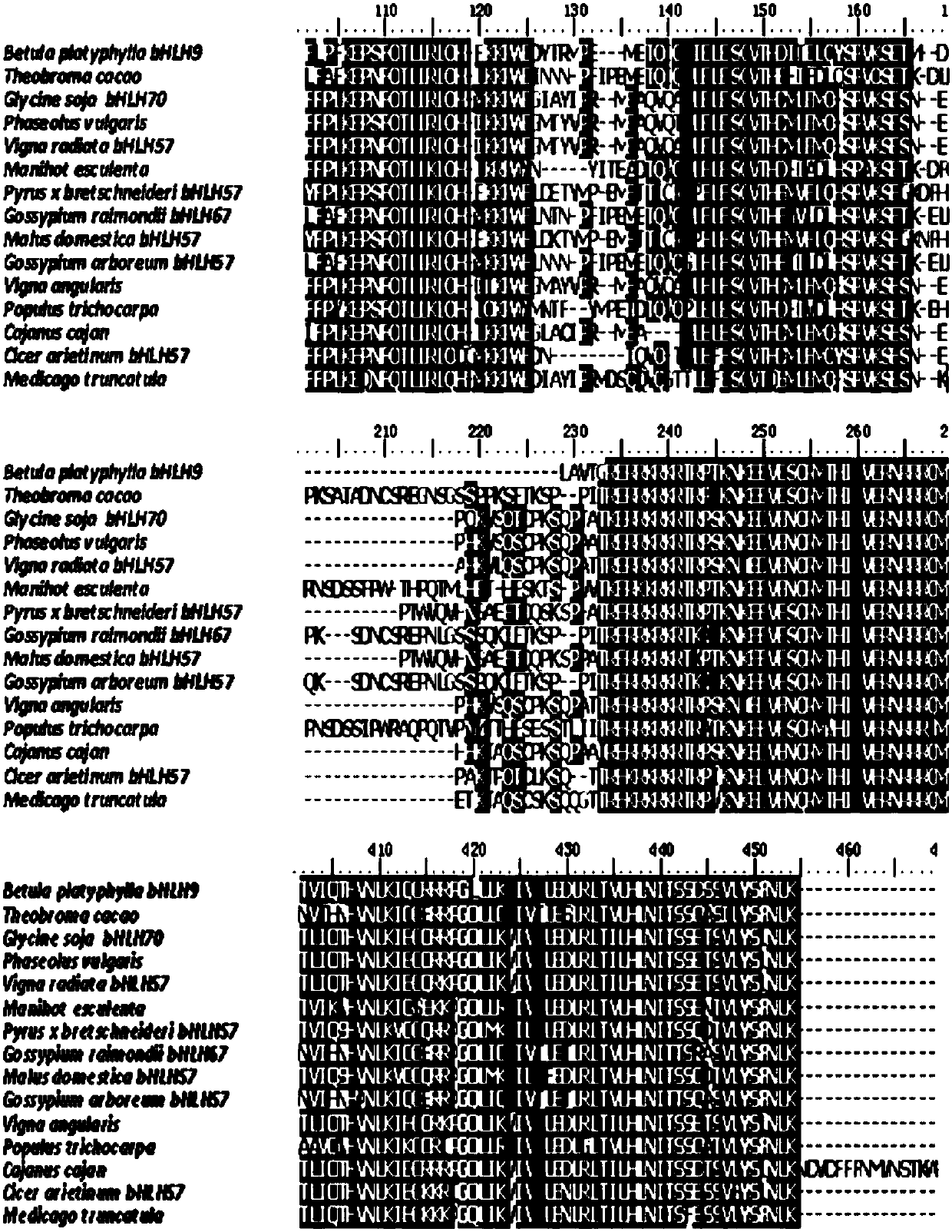Application of betula platyphylla suk. bHLH9 protein in regulation of synthesis of triterpenoids
A technology of triterpenoids and compounds, applied in the application field of birch bHLH9 protein in regulating the synthesis of triterpenoids, can solve the problem of under-understanding and excavation, complex secondary metabolic pathways, limited understanding of anabolic mechanisms and regulatory networks And other issues
- Summary
- Abstract
- Description
- Claims
- Application Information
AI Technical Summary
Problems solved by technology
Method used
Image
Examples
Embodiment 1
[0070] Example 1, BpbHLH9 cDNA full-length cloning and bioinformatics analysis
[0071] 1. Obtaining the full length of the BpbHLH9 gene
[0072] Specific primers were designed according to the two ends of the known sequence of bHLH9 gene in the birch transcriptome database, and the reverse transcription product of birch total RNA was used as a template, and bHLH9-F / R was used as primers for PCR amplification to obtain PCR products. The primer sequences are as follows:
[0073] bHLH9-F: GGTGCCTCTCTTCTCGTGTT;
[0074] bHLH9-R: GCGGTAGATATGTCTCCTTCTG.
[0075] The resulting PCR product was subjected to 1% agarose gel electrophoresis, and a specific band with a size of about 1300bp was detected and sequenced.
[0076] Sequencing results showed that a band with a size of 1243bp was amplified by PCR, and its nucleotide sequence was shown in sequence 1, and the gene shown in positions 69-1208 of sequence 1 was named BpbHLH9. The amino acid sequence of the protein encoded by the ...
Embodiment 2
[0087] Example 2, the acquisition of BpbHLH9 yeast and the impact of BpbHLH9 on squalene and total triterpene content
[0088] 1. Acquisition of BpbHLH9-transformed yeast
[0089] 1. Construction of yeast expression vector
[0090] Insert the BpbHLH9 gene sequence shown at positions 24-1241 of Sequence 1 between the BamHI restriction sites of the vector pYES3 / CT (Invitrogen, catalog number V8253-20), and keep other sequences of the vector pYES3 / CT unchanged, The yeast expression vector pYES3-bHLH9 was obtained. Yeast expression vector pYES3-bHLH9 expresses BpbHLH9 protein.
[0091]The DNA sequence shown in Sequence 3 was inserted between the HindIII restriction sites of the vector pYES2 (Invitrogen, catalog number V825-20), and the other sequences of the vector pYES2 were kept unchanged to obtain the yeast expression vector pYES2-SS. Wherein, the 53rd-1294th position of sequence 3 is the BpSS gene sequence, and the BpSS protein encoded by it is squalene synthase.
[0092] ...
Embodiment 3
[0127] Example 3, the acquisition of BpbHLH9 birch and the functional analysis of BpbHLH9
[0128] 1. Obtaining BpbHLH9 Baihua
[0129] 1. Construction of expression vector
[0130] Insert the BpbHLH9 nucleotide sequence shown in the 67th-1205th position of Sequence 1 between the Nco1 restriction sites of the vector pCAMBIA1303 (Youbao Biology, catalog number VT1844), and keep other sequences of the pCAMBIA1303 vector unchanged to obtain expression Vector pCAMBIA1303-BpbHLH9.
[0131] 2. Construction of recombinant bacteria
[0132] The expression vector pCAMBIA1303-BpbHLH9 was transformed into LBA4404 Agrobacterium tumefaciens (Beijing Dingguo Biotechnology Co., Ltd., catalog number: MCC026) to obtain the recombinant strain LBA4404-pCAMBIA1303-BpbHLH9.
[0133] 3. Acquisition and identification of BpbHLH9 birch
[0134] Agrobacterium tumefaciens LBA4404 containing the expression vector pCAMBIA1303-BpbHLH9 was used to infect the leaves, petioles and stems of birch tissue c...
PUM
 Login to View More
Login to View More Abstract
Description
Claims
Application Information
 Login to View More
Login to View More - R&D
- Intellectual Property
- Life Sciences
- Materials
- Tech Scout
- Unparalleled Data Quality
- Higher Quality Content
- 60% Fewer Hallucinations
Browse by: Latest US Patents, China's latest patents, Technical Efficacy Thesaurus, Application Domain, Technology Topic, Popular Technical Reports.
© 2025 PatSnap. All rights reserved.Legal|Privacy policy|Modern Slavery Act Transparency Statement|Sitemap|About US| Contact US: help@patsnap.com



